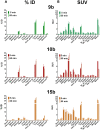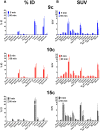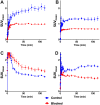Development of a ghrelin receptor inverse agonist for positron emission tomography
- PMID: 33747360
- PMCID: PMC7939532
- DOI: 10.18632/oncotarget.27895
Development of a ghrelin receptor inverse agonist for positron emission tomography
Abstract
Imaging of Ghrelin receptors in vivo provides unique potential to gain deeper understanding on Ghrelin and its receptors in health and disease, in particular, in cancer. Ghrelin, an octanoylated 28-mer peptide hormone activates the constitutively active growth hormone secretagogue receptor type 1a (GHS-R1a) with nanomolar activity. We developed novel compounds, derived from the potent inverse agonist K-(D-1-Nal)-FwLL-NH2 but structurally varied by lysine conjugation with 1,4,7-triazacyclononane,1-glutaric acid-4,7-acetic acid (NODAGA), palmitic acid and/or diethylene glycol (PEG2) to allow radiolabeling and improve pharmacokinetics, respectively. All compounds were tested for receptor binding, potency and efficacy in vitro, for biodistribution and -kinetics in rats and in preclinical prostate cancer models on mice. Radiolabeling with Cu-64 and Ga-68 was successfully achieved. The Cu-64- or Ga-68-NODAGA-NH-K-K-(D-1-NaI)-F-w-L-L-NH2 radiotracer were specifically accumulated by the GHS-R1a in xenotransplanted human prostate tumor models (PC-3, DU-145) in mice. The tumors were clearly delineated by PET. The radiotracer uptake was also partially blocked by K-(D-1-Nal)-FwLL-NH2 in stomach and thyroid. The presence of the GHS-R1a was also confirmed by immunohistology. In the arterial rat blood plasma, only the original compounds were found. The Cu-64 or Ga-68-NODAGA-NH-K-K-(D-1-NaI)-F-w-L-L-NH2 radiolabeled inverse agonists turned out to be potent and safe. Due to their easy synthesis, high affinity, medium potency, metabolic stability, and the suitable pharmacokinetic profiles, they are excellent tools for imaging and quantitation of GHS-R1a expression in normal and cancer tissues by PET. These compounds can be used as novel biomarkers of the Ghrelin system in precision medicine.
Keywords: cancer; copper-64; growth hormone secretagogue receptor (GHS-R); prostate cancer; small animal imaging.
Copyright: © 2021 Bergmann et al.
Conflict of interest statement
CONFLICTS OF INTEREST Authors have no conflicts of interest to declare.
Figures













Similar articles
-
68Ga-Labeled NODAGA-conjugated ghrelin receptor agonists and inverse agonists.2012 Jun 10 [updated 2012 Jul 12]. In: Molecular Imaging and Contrast Agent Database (MICAD) [Internet]. Bethesda (MD): National Center for Biotechnology Information (US); 2004–2013. 2012 Jun 10 [updated 2012 Jul 12]. In: Molecular Imaging and Contrast Agent Database (MICAD) [Internet]. Bethesda (MD): National Center for Biotechnology Information (US); 2004–2013. PMID: 22787690 Free Books & Documents. Review.
-
Developing new PET tracers to image the growth hormone secretagogue receptor 1a (GHS-R1a).Nucl Med Biol. 2017 Sep;52:49-56. doi: 10.1016/j.nucmedbio.2017.06.002. Epub 2017 Jun 10. Nucl Med Biol. 2017. PMID: 28628775
-
Design, evaluation, and comparison of ghrelin receptor agonists and inverse agonists as suitable radiotracers for PET imaging.Bioconjug Chem. 2012 Apr 18;23(4):771-84. doi: 10.1021/bc2005889. Epub 2012 Mar 20. Bioconjug Chem. 2012. PMID: 22372770
-
Adenosine does not bind to the growth hormone secretagogue receptor type-1a (GHS-R1a).J Endocrinol. 2006 Oct;191(1):147-57. doi: 10.1677/joe.1.06714. J Endocrinol. 2006. PMID: 17065398
-
Heterogeneity of ghrelin/growth hormone secretagogue receptors. Toward the understanding of the molecular identity of novel ghrelin/GHS receptors.Neuroendocrinology. 2007;86(3):147-64. doi: 10.1159/000105141. Epub 2007 Jul 2. Neuroendocrinology. 2007. PMID: 17622734 Review.
Cited by
-
Advances in the Development of Nonpeptide Small Molecules Targeting Ghrelin Receptor.J Med Chem. 2022 Feb 24;65(4):3098-3118. doi: 10.1021/acs.jmedchem.1c02191. Epub 2022 Feb 14. J Med Chem. 2022. PMID: 35157454 Free PMC article. Review.
References
-
- Liu H, Luo J, Guillory B, Chen JA, Zang P, Yoeli JK, Hernandez Y, Lee II, Anderson B, Storie M, Tewnion A, Garcia JM. Ghrelin ameliorates tumor-induced adipose tissue atrophy and inflammation via Ghrelin receptor-dependent and -independent pathways. Oncotarget. 2020; 11:3286–302. 10.18632/oncotarget.27705. - DOI - PMC - PubMed
LinkOut - more resources
Full Text Sources
Other Literature Sources
Miscellaneous

